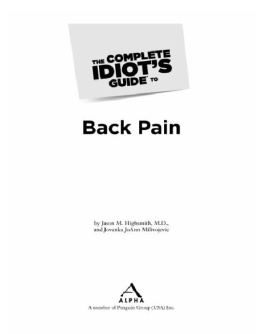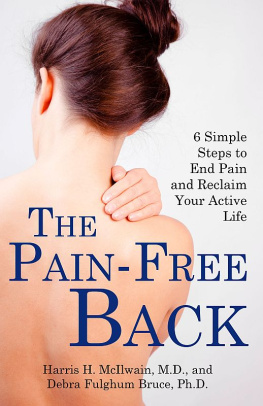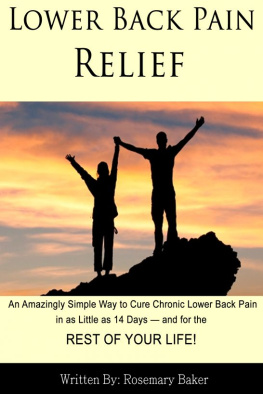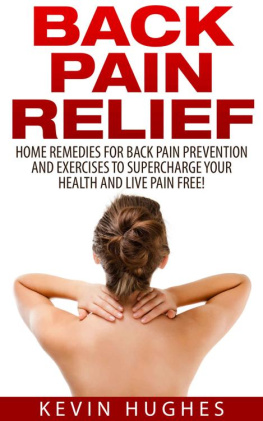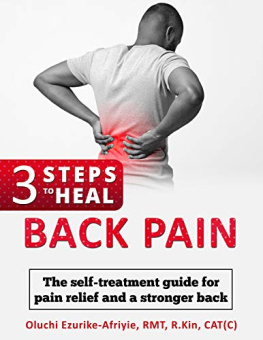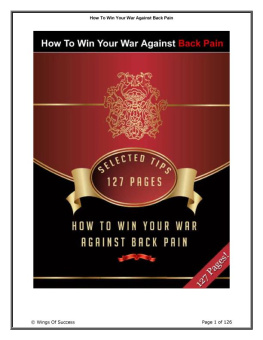Appendix A
Glossary
acute pain Pain that comes on suddenly and lasts only a few weeks or less.
addiction A dependence that occurs when there are adaptive changes in the brain leading to uncontrollable craving for a substance.
alternative medicine Therapies and practices considered outside of conventional medicine, such as massage and acupuncture. In general, alternative medicine is less invasive (meaning not penetrating the body, such as with surgery), gentler, and based on nature (such as herbal medicine). The practice tends toward holistic practices in that it evaluates the whole person: mind, body, and spirit. Alternative medicines are sometimes used in place of conventional medicinefor example, taking ginger to calm nausea instead of Pepto Bismol.
articulation The motion that occurs between joints. For example, certain facet joints in the spine allow for up, down, side-to-side, and twisting movements.
bone spurs Known in medical terminology as osteophytes, a piece of extra bone formed when the body is trying to repair itself. This growth can occur when there is prolonged pressure, rubbing, or stress on bones. When cartilage wears away, a spur may develop. This is not a problem if no other structure is affected, but in the spine, bone spurs might narrow spaces where spinal nerves travel and pinch them.
cartilage Basically smooth, rubbery connective tissue. Your nose is composed of it as are your ears. Cartilage caps the ends of bones, providing cushion and lubrication enabling bones to move easily. When cartilage wears away, bone grinds on bone, causing pain and deterioration. Osteoarthritis and rheumatoid arthritis are two common diseases that damage joint cartilage. In the spine, facet joints are covered with cartilage.
chronic pain Pain that, as typically defined, persists for longer than six months.
coccydynia A painful condition involving swelling around your tailbone. When the ligaments and tendons in this area become inflamed, it hurts to sit. You can also get this pain from a fracture of the coccyx, which can happen if you fall and land on your tailbone.
complementary medicine Refers to using alternative medicine in combination with conventional practices. These may be patient selected or doctor recommended. For example, using massage and chiropractic methods along with ibuprofen to treat back pain.
connective tissue Broadly, the various types of tissue that connect and support structures in the body. Its literally everywhere in the body. Collagen, tendons, and even muscles are types of connective tissue. Fascia, a type of connective tissue that lies just under the surface of the skin, can tighten and cause pain in various parts of the body, including the back. Some diseases such as rheumatoid arthritis are considered connective tissues disorders.
conventional medicine The medical system youre most familiar with, in which medical doctors and other health-care professionals (such as nurses, pharmacists, and therapists) diagnose and treat symptoms and diseases using drugs, therapy, or surgery. Its also called allopathic medicine, mainstream medicine, and Western medicine.
dorsal horn An area of your spinal cord that receives sensory information from your body, such as touch. The information is processed through two types of cells: transmission cells, which open the pain gate and allow pain signals to travel to the brain; and inhibitory cells, which keep the pain gate closed and help block pain perception.
endorphins Chemicals that the human body produces in response to pain. Drugs made from opiates can stimulate endorphin receptors. They mimic the bodys natural pain-killing abilities. Morphine, codeine, opium, and heroin are examples of opiates, drugs derived from the opium poppy.
facet joint The paired joint formed in the back where two vertebrae meet. It is often overlooked as a source of pain.
foramin In anatomical terms, any opening within the body. The plural form is foramina. The term usually refers to a space within or between bones, but it can mean a natural opening within tissues as well.
fractures Cracks in a bone. They can occur in the vertebrae due to disease, overuse, or severe trauma such as a car accident or a fall.
functional training Exercises that support what you do every day, such as standing, picking up children, or climbing up stairs. Well-designed programs build strength and flexibility, which enhance natural movements and coordination between muscles and the nervous system.
integrative medicine A system of medical therapy defined by the National Center for Complementary and Alternative Medicine at the National Institutes of Health as follows: integrative medicine combines mainstream medical therapies and CAM therapies for which there is some high-quality scientific evidence of safety and effectiveness. Conventional medical doctors who incorporate these therapies are called integrative.
intervertebral discs The cushion between each vertebra. The disc is composed of two parts: an inner gel-like nucleus, the nucleus pulposus; and a tough outer part, the annulus fibrosus.
intervertebral foramina The holes through which the nerves leave the spine. These holes are the spaces between the upper and lower vertebral bodies. The space is naturally rather narrow. If the space narrows more due to trauma or disease, nerves can get pinched.
joint The place where two bones come together. In the spine, the joint formed at the meeting of two vertebrae is called a facet joint. Like anywhere in the body, joints can swell and pinch nerves. Many people focus on the discs as a source of back pain although the facet joints are often to blame.
ligaments Strong fibrous bands that connect bone to bone. Their main job is to stabilize bones, holding them in place. They do, however, have a little flexibility.
neuromuscular reeducation A therapeutic process for neuromuscular disorders. Muscles and nerves work together to create movement. Over time, we develop habitual patterns of movement (some good, some not). These are stored in our muscle memory. When there are repetitive poor patterns, trauma, or damage to nerves or muscles, we may need to relearn movements or learn how to do them correctly. That relearning process is called neuromuscular reeducation.
neuropathic pain Nerve-based pain that reflects trauma, irritation, or chronic changes in nerves. Neuropathic agents are more effective against nerve-related pain.
neuroplasticity A relatively new concept about how our nervous system participates in memory. When we learn new concepts or experience events, nerves send signals to one another, creating connections that can evolve. Through repetition and intensity, lasting connections among neural pathways are made.
nociceptive pain Pain that originates from tissues in the body (muscle, disc, bone) and is transmitted by the nerves.
peripheral nervous system (PNS) The collective of the millions of nerves throughout your torso and limbs. PNS nerves convey messages to your central nervous system (CNS), which consists of the brain and spinal cord.
placebo Inert pills used in clinical trials. They used to be made of sugar, but then they were easily detected as such by the study participants. Now they are a safe but tasteless substance with no biochemical effect. They help determine whether or not a particular substance is effective by comparing outcomes of participants taking placebo versus those who dont.
regenerative medicine The field of tissue regeneration using stem cells.

